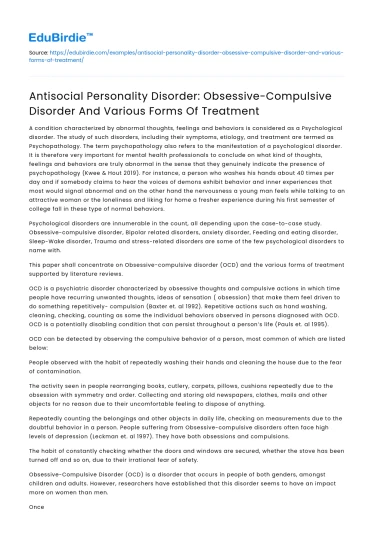A condition characterized by abnormal thoughts, feelings and behaviors is considered as a Psychological disorder. The study of such disorders, including their symptoms, etiology, and treatment are termed as Psychopathology. The term psychopathology also refers to the manifestation of a psychological disorder. It is therefore very important for mental health professionals to conclude on what kind of thoughts, feelings and behaviors are truly abnormal in the sense that they genuinely indicate the presence of psychopathology (Kwee & Hout 2019). For instance, a person who washes his hands about 40 times per day and if somebody claims to hear the voices of demons exhibit behavior and inner experiences that most would signal abnormal and on the other hand the nervousness a young man feels while talking to an attractive woman or the loneliness and liking for home a fresher experience during his first semester of college fall in these type of normal behaviors.
Psychological disorders are innumerable in the count, all depending upon the case-to-case study. Obsessive-compulsive disorder, Bipolar related disorders, anxiety disorder, Feeding and eating disorder, Sleep-Wake disorder, Trauma and stress-related disorders are some of the few psychological disorders to name with.
Save your time!
We can take care of your essay
- Proper editing and formatting
- Free revision, title page, and bibliography
- Flexible prices and money-back guarantee
This paper shall concentrate on Obsessive-compulsive disorder (OCD) and the various forms of treatment supported by literature reviews.
OCD is a psychiatric disorder characterized by obsessive thoughts and compulsive actions in which time people have recurring unwanted thoughts, ideas of sensation ( obsession) that make them feel driven to do something repetitively- compulsion (Baxter et. al 1992). Repetitive actions such as hand washing, cleaning, checking, counting as some the individual behaviors observed in persons diagnosed with OCD. OCD is a potentially disabling condition that can persist throughout a person’s life (Pauls et. al 1995).
OCD can be detected by observing the compulsive behavior of a person, most common of which are listed below:
People observed with the habit of repeatedly washing their hands and cleaning the house due to the fear of contamination.
The activity seen in people rearranging books, cutlery, carpets, pillows, cushions repeatedly due to the obsession with symmetry and order. Collecting and storing old newspapers, clothes, mails and other objects for no reason due to their uncomfortable feeling to dispose of anything.
Repeatedly counting the belongings and other objects in daily life, checking on measurements due to the doubtful behavior in a person. People suffering from Obsessive-compulsive disorders often face high levels of depression (Leckman et. al 1997). They have both obsessions and compulsions.
The habit of constantly checking whether the doors and windows are secured, whether the stove has been turned off and so on, due to their irrational fear of safety.
Obsessive-Compulsive Disorder (OCD) is a disorder that occurs in people of both genders, amongst children and adults. However, researchers have established that this disorder seems to have an impact more on women than men.
Once observed and diagnosed, getting treatment as soon as possible may help prevent OCD from worsening and disrupting activities and one’s daily routine. OCD usually develops into a chronic condition if left untreated, with episodes where symptoms seem to improve. Without treatment, remission rates are low. However around 40 percent of people who develop OCD in childhood experience remission by early adulthood. Treatment for OCD will depend on how much the condition affects the person’s ability to function.
The basic treatment for OCD will often include :
- Cognitive-behavioral therapy (CBT)
- Selective Serotonin reuptake inhibitors (SSRI)
The treatment for this pattern of psychological disorder involves drug and behavior therapy. Medications that are strong in serotonin reuptake inhibitors and specific behavioral therapies that employ the principles of exposure and response- prevention are highly effective in reducing the symptoms of OCD (Baxter et. al 1992). Although the latter was found to be more effective for reducing compulsion behaviors than an obsession.
Based on a wide range of evidence, many investigators have established the role of human brain to be the mediator for OCD symptoms. Pinpointing the head of the caudate nucleus playing a prime role in OCD symptoms, successful treatment of OCD by either medication or behavior therapy accompanied by a change in caudate nucleus function detected either positron emission tomography [PET] and the 18-F-flouorodeoxyglucose{FDG] method.
A study done on OCD patients with FDG-PET before and after either drug or behavior therapy done choosing fluoxetine hydrochloride as the treatment drug revealed that glucose metabolic rates in the right head of the caudate nucleus changed when OCD treated successfully with either fluoxetine or behavior therapy (Leckman et. al 1997).
Without treatment, mild OCD can improve, but moderate to severe OCD will not improve and often get worse. Successful treatments can significantly improve and even cure OCD. However, the condition can return later on.
References:
- Lewis R. Baxter, Jeffrey M. Schwartz, Kenneth S. Bergman, Martin P. Szuba,
- Barry H. Guze, John C. Mazziotta, Adina Alazraki; Carl E. Selin, Huan-Kwang Ferng, Paul Munford, Michael E. Phelps 1992, ‘Caudate Glucose Metabolic Rate Changes With Both Drug and Behavior Therapy for Obsessive-Compulsive Disorder’, Arch Gen Psychiatry, 1992, vol. 49, no. 9, pp. 681–689.
- Caroline M.B Kwee & Marcel A. van den Hout 2019, ‘Anxiety sensitivity does not predict treatment outcome or treatment length in obsessive-compulsive disorder and related anxiety disorders’, Journal of Obsessive-Compulsive and Related Disorders, vol. 21, pp.18-25.
- David L. Pauls, John P. Alsobrook, W. Goodman, S. Rasmussen, & James F. Leckman 1995, ‘A family study of obsessive-compulsive disorder’, American Journal of Psychiatry, vol. 152, no.1, pp.76-84.
- James F. Leckman, Dorothy E. Grice, James Boardman, Heping Zhang, Amy Vitale, Colin Bondi, John Alsobrook, Bradley S. Peterson, Donald J. Cohen, Steven A. Rasmussen, Wayne K. Goodman, Christopher J. McDougle, and David L. Pauls 1997, ‘Symptoms of obsessive-compulsive disorder’, American Journal of Psychiatry, vol.154, no.7, pp.911-917.






 Stuck on your essay?
Stuck on your essay?

